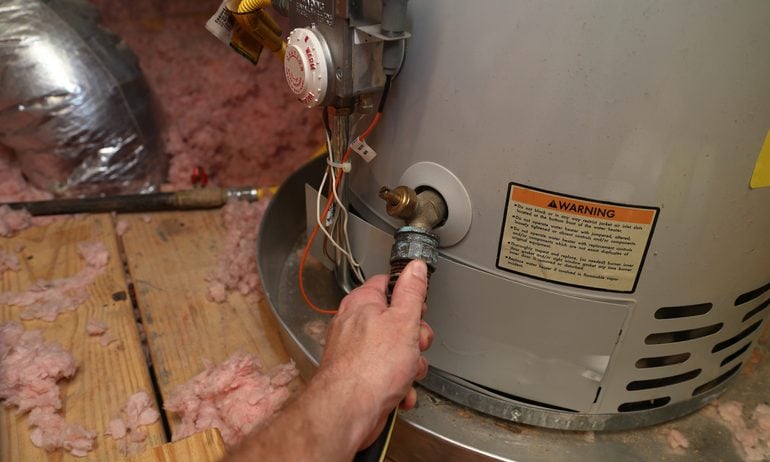How Much Does a Water Heater Cost in 2025?
The cost to replace and install a water heater depends on the model you choose, labor, location and more.

Some or all of the mortgage lenders featured on our site are advertising partners of NerdWallet, but this does not influence our evaluations, lender star ratings or the order in which lenders are listed on the page. Our opinions are our own. Here is a list of our partners.
A water heater typically costs $600 to $2,500 for a traditional tank and between $1,400 and $3,900 for a tankless water heater. These costs include installation. The average cost of a water heater is $1,327.
In general, tankless water heaters are more expensive to install than storage tank models, particularly if you’re replacing a tank model with a tankless one because of the additional labor needed. While installing a tank-style water heater can cost as little as $150, converting from tank-style to tankless can cost as much as $2,500.
Traditional tank-style water heater costs
Replacing a tank-style water heater usually costs between $600 and $2,500.
A conventional tank-style water heater heats water electrically and stores the heated water in an insulated tank until it’s needed. These units come in a variety of sizes, last around 10 to 15 years and are the least expensive type of water heater.
A number of features affect the price of a tank-style water heater, including:
The size of your water heater. The more gallons of water your tank can hold, the more the unit will generally cost.
Fuel type. Electric, propane and natural gas water heaters have similar starting price points, but if you need to install a gas line or alter your electric system, this can raise your costs. High-end electric, solar and hybrid heat pump units tend to be the priciest.
Water heater brand and features. Some brands, such as Rheem or A.O. Smith, tend to be more expensive than brands like Whirlpool or Kenmore. Additionally, high-end features such as anti-scale mechanisms, smart controls and energy-saving tech may increase your total price.
Venting system. A direct-vent model that uses an already-existing chimney is generally significantly less expensive than installing a power-vent unit.
Traditional water heater warranty
Manufacturer warranties for storage tank water heaters vary from company to company, so it’s important to read the warranty of any water heater you’re considering. These warranties often last six years, but some may continue up to 12 years.
Covered areas may include the inner tank, component parts, return of defective parts and labor, as long as there is no misuse, improper installation, tampering or damage from flooding or other extreme conditions — and different covered areas within the same warranty may have longer or shorter coverage periods.
Tankless water heater costs
Tankless water heater costs range from about $1,400 to $3,900, including installation.
Tankless water heaters deliver a constant, on-demand supply of hot water without the need for a storage tank. These water heaters accomplish this through flashes of intense heat against water-filled coils.
Tankless water heaters are much smaller and have a longer lifespan (about 20 years) than storage tank models — and they also have the potential to use less energy, depending on the individual household’s water usage behaviors.
Some factors that affect the price of tankless water heaters include:
Special features. Energy-efficient certification and high-end features usually add to the cost.
Fuel type. Gas-powered units generally cost significantly more than electric-powered units.
Warranty length. A longer warranty may factor into the price.
System size. The higher the gallons-per-minute rating, the more the unit typically costs.
Tankless water heater warranty
Tankless water heater warranties can extend as long as 25 years or even a limited lifetime period, but some manufacturers offer significantly shorter coverage periods. Be aware that different parts of your warranty coverage may have different coverage periods. As long as you’ve properly cared for your unit, areas covered by tankless water heater warranties may include:
The heat exchanger.
Other replacement parts.
Labor to diagnose problems and to repair or replace parts.
Because warranties can vary so much in coverage and duration, it makes sense to read the fine print on manufacturer warranties carefully before making a purchase.
Cost to replace a water heater
In addition to the type of heater, several other factors affect water heater installation costs:
Labor costs. The more hours of electrical, carpentry and plumbing work that are required for your installation (for example, installing new electric, water or gas lines or drywall), the higher your total water heater replacement costs.
Location of unit. If your water heater needs to be installed in a spot that’s hard to access, such as in a very tight space or up or down flights of stairs, this can add to the cost. Relocating your water heater also adds to the complexity and cost of installation.
Permits. The cost of required permits will add to your total installation expense, typically from $25 to $300.
Geographic area. Some areas of the country have higher average installation costs.
Water heater installation tips
Using a reputable, experienced contractor for installation can help avoid some areas that are commonly overlooked. These include:
Seismic mitigation strapping. If water heaters aren’t properly secured and an earthquake happens, this can cause broken gas lines, fires, broken water lines and flooding .
Plumbing codes. DIY installs may not take plumbing codes into consideration, resulting in code violations and possible fines, leaks or safety issues.
Permits. Your town or city may require a permit for water heater installation, as well as secondary plumbing or electrical permits. Neglecting this could result in code violations and possible fines and safety issues.
Voiding of warranty. DIY or improper installation could void your warranty.
Improper location. Installing your water heater in a difficult-to-reach spot can make contractors reluctant or unwilling to service it if you have problems over the years. Additionally, certain locations are code violations due to possible CO emissions. Areas where water heaters are prohibited include storage closets, toilet rooms, bathrooms and bedrooms.
Can I get financing for a home repair or improvement?
Your contractor may offer some financing options (either through a partner or a payment plan), but there are other — any maybe better — financing options available.
Which financing option is best for me?
The best financing option for you will depend on how much money you need, when you need the money, what project you’re doing and how long you need to pay the money back. If it’s something that’ll add value to your home, a HELOC or home equity loan may be your best option because the value of your house could increase by more than the amount of the loan.
On the flip side, if it’s a less expensive repair, a credit card is probably your best option if you want to pay no interest or earn rewards. Personal loans can apply to both small and large repairs or renovations, and they may make sense if you don’t have much equity in your home.
Some home improvement contractors offer their own financing options. Before taking this option, shop around and see how their offer compares with other loans.
Regardless of what you choose, make sure you compare interest rates, terms and fees with any financing options you’re considering. This will ensure you get the best deal.




